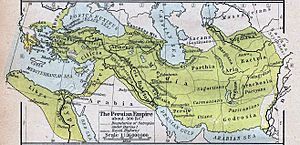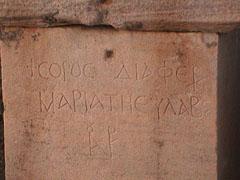History of ancient Lebanon facts for kids
The history of ancient Lebanon tells the story of the land we now call Lebanon, from the very old times until the Arab rule began. This area is in the eastern part of the Mediterranean Sea.
Contents
Prehistoric Times
People first settled in Lebanon a very long time ago, even before 5000 BC. In Byblos, which is thought to be the oldest city where people have lived continuously, scientists have found signs of early homes. These homes had floors made of crushed limestone. They also found simple weapons and special jars used for burials. This shows that fishing communities lived on the Mediterranean coast over 8,000 years ago, during the Neolithic (New Stone Age) and Chalcolithic (Copper Age) periods.
Bronze Age
Around 4000 BC, this area was first written about in history. It was a place with many cities along the coast and thick forests inland. The Canaanites, a Semitic people, lived here. The Greeks later called them "Phoenicians" because they sold a special purple dye. These early people called themselves things like "men of Sidon," depending on their home city. The Canaanites built independent city-states and set up colonies all over the Mediterranean Sea. They were more like a powerful trading network than a big empire with one capital city.
Each coastal city was its own independent state, known for different things. Tyre and Sidon were important places for sea travel and trade. Gubla (later known as Byblos and today as Jbeil) and Berytus (now Beirut) were centers for trade and religion. Gubla was the first Canaanite city to trade a lot with Egypt and its pharaohs during the Old Kingdom (2686-2181 BC). They sent cedar wood, olive oil, and wine to Egypt. In return, they received gold and other goods from the Nile Valley.
Before the late 17th century BC, trade between the Canaanites and Egyptians stopped. This happened when the Hyksos, a group of nomadic people, took over Egypt. After about 30 years of Hyksos rule (1600-1570 BC), an Egyptian prince named Ahmose I (1570-1545 BC) started a war to free Egypt. The fight against the Hyksos grew stronger, especially during the time of Pharaoh Thutmose III (1490-1436 BC). He invaded the area now called Syria, ended the Hyksos' power, and made Canaan part of the Egyptian Empire.
By the end of the 14th century BC, the Egyptian Empire became weaker. This allowed the city-states to become more independent by the early 12th century BC. The next three centuries were a time of great success and freedom from foreign control. During this time, the Canaanites' earlier invention of the alphabet made communication and trade much easier. The Canaanites were also very skilled at making textiles (cloth), carving ivory, working with metal, and especially making glass. They were expert sailors and founded colonies wherever they traveled in the Mediterranean Sea. This included places like Cyprus, Rhodes, Crete, and Carthage. They also set up trade routes to Europe and western Asia. These colonies and trade routes did very well until the Assyrians invaded the coastal areas.
Trade Routes in the Beqa Valley
During the Middle Bronze Age, the Beqa Valley was a major route for trade. Goods moved between the Kingdom of Qatna in the north and the Kingdom of Hazor in the south. Hazor might have been under Qatna's control, meaning Qatna influenced the whole region. Kamid el-Loz in the valley had a palace and a temple. It was a central point for trade routes going north-south and east-west. These routes connected to cities like Beirut, Sidon, Hazor, Damascus, Tell Hizzin, and Baalbek.
Later, in the Late Bronze Age, the Beqa Valley was controlled by an Egyptian governor from Kamid el-Loz. The northern part of the valley was used for grazing animals and was a border area with Kadesh in the north. At first, Syria was part of the Mitanni Empire. But after military actions by Suppiluliuma I of Hatti (around 1350 BC), Kadesh became a strong point for the Hittite Empire, facing the Egyptian Empire in the south. We know about this time from writings found in the Amarna Archive.
Iron Age II - Phoenicia
Assyrian Period

Assyrian rule (875-608 BC) took away the independence and wealth of the Canaanite city-states. This led to many unsuccessful rebellions. In the mid-8th century BC, Tyre and Byblos rebelled. But the Assyrian ruler, Tiglath-Pileser III, defeated them and made them pay large amounts of tribute. The harsh rule continued, and Tyre rebelled again, this time against Sargon II (722-705 BC). He successfully surrounded the city in 721 BC and punished its people. In the 7th century BC, Sidon rebelled and was completely destroyed by Esarhaddon (681-668 BC). Its people were forced into slavery. Esarhaddon built a new city on Sidon's ruins. By the end of the 7th century BC, the Assyrian Empire was weakened by many revolts and was finally destroyed by the Median Empire.
Babylonian Period
When the Babylonians finally defeated the Assyrians at Carchemish, they already controlled much of the Canaan region. This land was taken from the falling Assyrian kingdom. During this time, two Babylonian kings ruled: Nabopolassar, who focused on ending Assyrian power, and his son Nebuchadnezzar II. Nebuchadnezzar II's reign saw several local rebellions, especially in Jerusalem. Revolts in Canaanite cities became more common. Tyre rebelled again and resisted a siege by Nebuchadnezzar's troops for thirteen years (587-574 BC). After this long siege, the city gave up. Its king was removed, and its citizens were enslaved.
Persian Period - Achaemenid Empire
Quick facts for kids Achaemenid Phoenicia |
|||||||||||||
|---|---|---|---|---|---|---|---|---|---|---|---|---|---|
| Province of the Persian Empire | |||||||||||||
| c.538 BC–c.332 BC | |||||||||||||
 Phoenicia within The Achaemenid Empire, 500 BC. |
|||||||||||||
| Historical era | Achaemenid Empire | ||||||||||||
|
• Cyrus the Great’s invasion of Babylonia
|
c.538 BC | ||||||||||||
|
• Conquests of Alexander the Great
|
c.332 BC | ||||||||||||
|
|||||||||||||
The Babylonian area of Phoenicia and its neighbors came under Achaemenid (Persian) rule. This happened when Cyrus the Great conquered Babylon in 539/8 BC.
The coastal cities of Syro-Canaan remained under Persian rule for the next two centuries. The Canaanite navy helped Persia during the Greco-Persian War (490-49 BC). But the Canaanites were forced to pay very high tributes by the kings who came after Darius I (521-485 BC). This led to new revolts and rebellions in the coastal city-states.
The Persian Empire, including the Canaan province, eventually fell to Alexander the Great, the king of Macedonia, in the 4th century BC.
Here are some important rulers under the Achaemenid Empire:
- Eshmunazar II
- Tabnit
- Baalshillem II
- Abdashtart I
- Tennes
Classical Antiquity
Macedonian Rule
The Persian Empire eventually fell to Alexander the Great, the king of Macedon. He attacked Asia Minor, defeated the Persian troops in 333 BC, and moved towards the eastern Mediterranean coast. At first, the Canaanite cities did not try to fight back. They accepted Alexander as their ruler. However, when Alexander tried to make an offering to Melqart, the god of Tyre, the city resisted. Alexander then surrounded Tyre in early 332 BC. After six months of fighting, the city fell, and its people were sold into slavery. Even though Alexander died young in 323 BC, his conquest of the eastern Mediterranean left a strong Greek influence on the area. The Phoenicians, who were open to new ideas, easily adopted parts of Greek culture.
The Seleucid Dynasty
After Alexander's death, his large empire was divided among his Macedonian generals. The eastern part, which included Canaan, Asia Minor, northern Syria, and Mesopotamia, went to Seleucus I. He was the founder of the Seleucid dynasty. The southern part of modern-day Syria and modern-day Egypt went to Ptolemy. The Balkan regions, including Macedonia, went to Antigonus I. However, this division did not bring peace because Seleucus I and Ptolemy fought many times. A final victory by the Seleucids ended a forty-year period of conflict.
Roman Rule
The last century of Seleucid rule was full of problems and power struggles. These ended in 64 BC, when the Roman general Pompey added Seleucid Syria and Canaan as a Roman province to the Roman Empire. During the time of Roman peace, called the Pax Romana, economic and intellectual activities thrived in Canaan. The people of the main Canaanite cities like Byblos, Sidon, and Tyre were given Roman citizenship. These cities were important centers for making pottery, glass, and purple dye. Their harbors also served as storage places for goods brought from eastern regions like Persia and India. They exported cedar wood, perfume, jewelry, wine, and fruit to Rome.
This economic success led to a lot of new building and city growth. Temples and palaces were built all over the country. Paved roads were also built, connecting major cities like Heliopolis and Berytus.
Starting in the late 1st century BC (during the rule of Augustus) and for about two centuries (until the rule of Philip the Arab), the Romans built a huge temple complex in Heliopolis (which is now Baalbek). This complex was built on an older mound and included three temples: Jupiter, Bacchus, and Venus. On a nearby hill, they built a fourth temple for Mercury.
Also, soldiers who had finished their service from two Roman legions were settled in the city of Berytus (now Beirut). These were the fifth Macedonian and the third Gallic legions. The city quickly became very Roman. Large public buildings and monuments were put up, and Berytus became a full part of the empire.

Under the Romans, Berytus became richer thanks to the family of Herod the Great. It was made a colonia, named Colonia Iulia Augusta Felix Berytus, in 14 BC. Beirut's law school was very famous at that time. Two of Rome's most well-known legal experts, Papinian and Ulpian, both from Canaan, taught at this law school during the time of the Severan emperors.
The city of Heliopolis was also made a colonia by Septimius Severus in 193 AD. It had been part of the Berytus area on the Canaanite coast since 15 BC. Work on the religious complex there lasted for over 150 years and was never fully finished. The dedication of the current temple ruins, which are the largest religious building in the entire Roman empire, dates from Septimius Severus's reign. His coins were the first to show the two temples. The large courtyards leading to the temples were not finished until the reigns of Caracalla (211-217 CE) and Philip the Arab (244-249 CE). To celebrate the new temples, Severus gave the city the rights of the ius Italicum. Today, only six Corinthian columns remain standing from this huge Jupiter temple.
Severus also separated the area of modern Lebanon and parts of Syria from the larger province of Syria Coele. He formed a new province called Phoenice.
When Theodosius I died in 395 AD, the Roman Empire was split into two parts. The eastern part, or Eastern Roman Empire, had its capital in Constantinople. The western part had its capital in Rome. Under the Byzantine Empire, intellectual and economic activities in Beirut, Tyre, and Sidon continued to do well for more than a century. However, in the late 6th century, a series of earthquakes destroyed the temples of Heliopolis and ruined the Romanized city of Beirut. Its famous law school was leveled, and nearly 30,000 people died. Besides these natural disasters, there were also problems like corruption and unfair practices in the empire. High taxes and religious disagreements caused disorder and confusion. Also, church councils in the 5th and 6th centuries could not solve religious arguments. This difficult time weakened the empire, making it an easy target for the newly converted Muslim Arabs from the Arabian Peninsula, who invaded the region in 642 AD.
See also
- History of Lebanon
- Laurence Waddell
- Frederick Haberman



